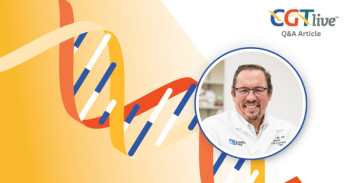
Early Momentum for a Genomic Approach to Sickle Cell Disease Therapy
In a late-breaking presentation at ASGCT 2022, investigators shared preclinical results of a gene-editing strategy that seeks to reactivate developmentally silenced fetal hemoglobin (HbF, α2γ2) in order to replace defective sickle hemoglobin (HbS, α2βS2).
Investigators evaluating a gene-editing strategy that seeks to reactivate developmentally silenced fetal hemoglobin (HbF, α2γ2) in order to replace defective sickle hemoglobin (HbS, α2βS2) in patients with sickle cell disease (SCD) reported encouraging results in a late-breaking oral presentation at the
Findings from the early stage clinical trial targeting BCL11A erythroid specific enhancer to induce fetal hemoglobin suggest that disruption of the -115 BCL11A repressor binding site in the γ-globin gene promoters can stimulate therapeutically effective levels of HbF and is a promising approach for genomic SCD therapy.
First, the research team compared editing of BCL11A (-115) with ZBTB7A (-198) binding motifs to determine which target, when edited with the γ-globin gene promoters, would produce the most robust HbF induction.
“We electroporated Cas9-3xNLS ribonucleoprotein complexes (RNPs) into human primary CD34+ hematopoietic stem and progenitor cells (HSPCs) and attained high editing rates ranging from 76.2% to 85.7%,” investigators reported.
Investigators observed consistent and high indel mutations frequencies of 63.5% to 92.7% in all hematopoietic lineages with no apparent impairment of multilineage differentiation some 17 weeks after transplanting the edited CD34+ cells into immunodeficient NBSGW mice.
They noted higher levels of HbF induction in erythroid progeny of CD34+ cells edited at the -115 γ-globin promoter target (31.8%) when compared with those edited at the - 198 ZBTB7A binding site (13%-18%).
The next step to further test the -115 γ-globin promoter editing approach in SCD patient cells was to edit plerixafor-mobilized CD34+ HSPCs from 1 healthy donor and 3 individuals with SCD.
“Seventeen weeks after transplanting edited cells into NBSGW mice, we observed consistently high rates of editing (75.1%) in all hematopoietic lineages, and substantial levels of HbF (27.6%) in erythroid progeny compared to controls (< 2.9%),” investigators reported. “Single cell western showed expression of gamma globin in a majority of edited erythroblasts (58%) compared to unedited controls (<6%). Moreover, RBCs derived from edited CD34+ cells from SCD patients exhibited significant 3-fold reduction in hypoxia-induced sickling.”
Lead author and presenter Varun Katta, senior research technologist at St. Jude Children's Research Hospital, reported that the team used CHANGE-seq discovery and rhAMP-seq validation and did not detect off-target mutations above background at 194 identified sites. Relying on PacBio-Hifi long-range sequencing, Katta and colleagues did note that a high-frequency large deletion occurred (4.9 kb) and resulted from simultaneous double strand beaks in HBG1 and HBG2 promoters.
“By digital droplet [polymerase chain reaction], we detected an average of 23.9% of this 4.9 kb deletion in engrafted cells at 17 weeks that has no apparent impact on erythropoiesis and HbF induction,” the team reported.
Next steps include plans for a future clinical trial in 2023 at St. Jude called the St. Jude Autologous Genome Edited Stem Cells (SAGES1) clinical trial.
Reference:
Katta V, O’Keefe K, Wood R, et al. Genome editing of human hematopoietic stem cells to induce fetal hemoglobin for autologous cellular therapy of sickle cell disease. Presented at: American Society of Gene & Cell Therapy 25th Annual Meeting; May 16-19, 2022; Washington, DC. Accessed May 16, 2022.
Newsletter
Stay at the forefront of cutting-edge science with CGT—your direct line to expert insights, breakthrough data, and real-time coverage of the latest advancements in cell and gene therapy.































